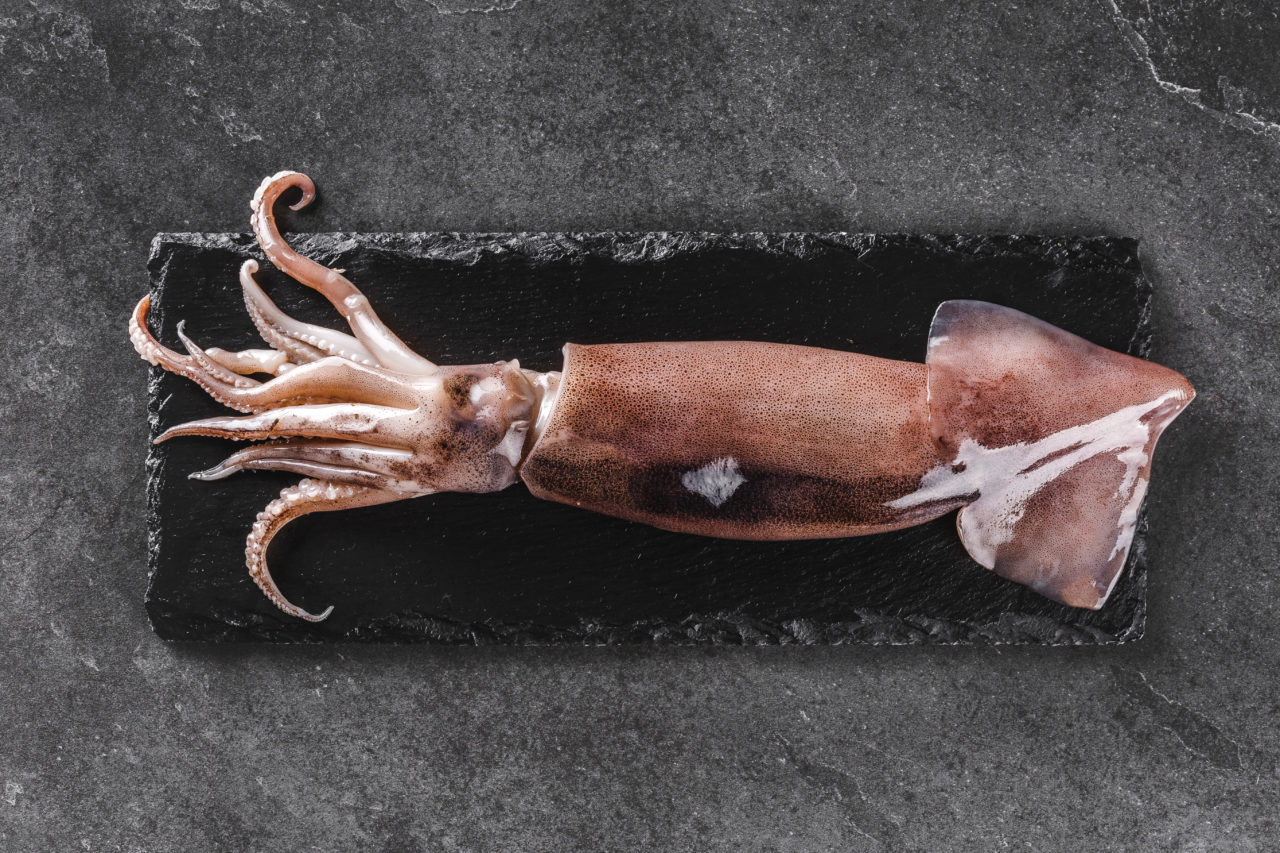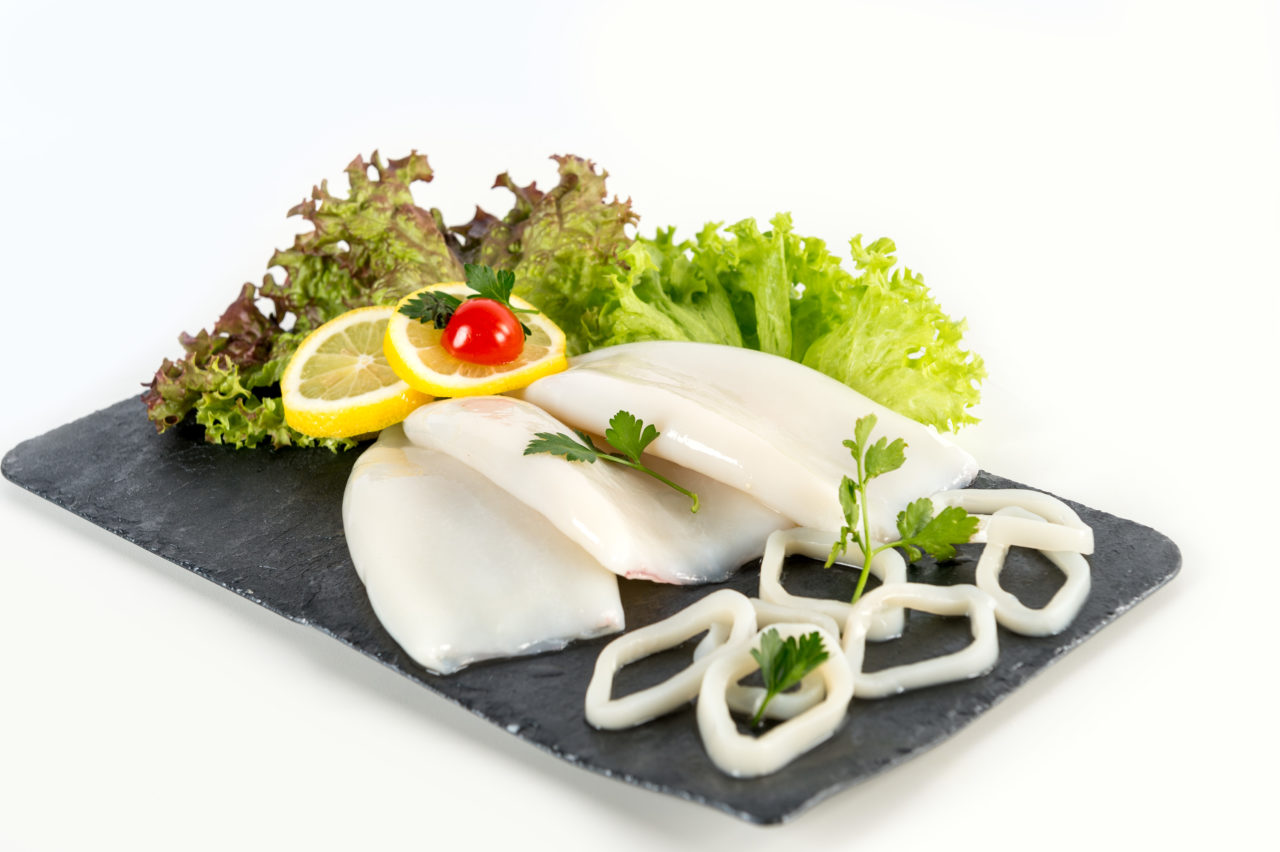Nederlands
English
Deutsch
Français
Squid is a true delicacy and a popular product worldwide. More and more people in the Netherlands are discovering that there is more to squid than just the tough squid rings dipped in doughnut batter.
It is not without reason that the squid tubes from Mooijer-Volendam are one of our best-selling products.
In this article, we explain in detail all the different types of squid products, the difference in quality and the reason for price differences between fish wholesalers.
The topics discussed in this article:
Squid are molluscs that live in saltwater all over the world. In Dutch they are called inktvis, the same name fisherman sometimes use to refer to cephalopods, which literally means ‘inkfish’. The species owe this characteristic name to its ink sac. When in danger, the ink is used as a weapon by squirting it into the water.
Despite its popularity, squid is wild-caught. A squid boat uses driftnets to catch the squid. This is in contrast to commonly sold products such as prawns or salmon.
Squid can adapt to change quickly, and they also reproduce fast. As a result, overfishing is not a problem. Californian and Argentinian waters are well-known areas where high-quality squid can be caught. The cheaper squid products often come from China.

There are many different types of squid worldwide, of which there are three squid types suitable for human consumption: squid, cuttlefish(Sepia) and octopus. Naturally, we focus on these three squid species in this article.
The most famous squid species in the fish industry is the common squid. You can recognise this species by its tubular body with eight arms and two tentacles that are smaller than its body. The common squid is sold as a whole, but the cleaned heads and tubes are also sold separately.
Mooijer-Volendam sells the Californian squid as a whole. The Californian squid is known for its tenderness, therefore a popular product. As the squid sold whole still contains its ink sac, it requires some knowledge when preparing this product.
However, most supermarkets, speciality stores or restaurants usually prefer to buy already cleaned and frozen squid tubes. This product is in high demand worldwide. Of course, these tubes can be cut into strips to make the popular calamari rings.

The cuttlefish or sepia has a somewhat broader and more rounded body than the common squid. The flesh of the sepia is a little thicker and firmer compared to the common squid due to the difference in its body shape.
Cuttlefish have many defences, but the most impressive of these is the ability to instantly change colour and shape. Therefore, camouflaging itself and making it less noticeable to enemies.
This squid species is rarely consumed in the Netherlands. However, sepia is very popular in Asia. Cuttlefish is sold frozen and as a whole sepia in the form of a pineapple.
Lastly, we have the octopus. This squid species looks very different from the common squid and thesepia. One of the differences between the common squid and the octopus is that the octopus only has eight arms instead of ten. This is also how the animal got its name, as ‘octo’ means eight in Latin. The two tentacles of this species have completely disappeared. Furthermore, the flesh of the octopus is naturally a lot tougher.
Generally, we sell octopus as a whole; therefore, it can vary in weight. In addition, Mooijer-Volendam also has baby octopus in its range of products and sells them per 1 kg bag.
Due to the enormous market for squid tubes, competition between the different suppliers is fierce. Everyone is looking for the best quality at the lowest price. To give you as a buyer or restaurant owner some guidance, we would like to tell you more about the quality differences between the squid species.
Generally, the ‘Arrow Squid‘ caught in the waters of New Zealand is the most valuable squid species. Selling prices of these good-quality squid tubes is the highest of them all.
The ‘Illex‘ squid is a popular squid species, usually priced slightly lower than the New Zealand Arrow Squid. The Illex are commonly caught along the coasts of Argentina.
Lastly, let’s talk about the ‘Todarodes‘ squid species. These squid tubes come from China and are often the cheapest. However, the low price has a downside as the quality of these squid tubes is substantially lower than that of the Illex or Arrow Squid.
Of course, it is possible that in some cases the above mentioned price ratios may deviate. All squid species are still wild-caught. That means prices can increase or drop depending on the number of squid caught. Scarcity is tied to an increase in prices.
In addition to the standard price difference between the Arrow Squid, Illex and Todarodes squid varieties, fish wholesalers have other ways to differentiate themselves with lower prices. As I already explained in my article about Black Tiger and Vannamei prawns , it is possible to add water to products.
Adding water is an easy and inexpensive way to increase the weight of the product. Water is a lot cheaper than squid, enabling wholesalers to sell their squid at cheaper prices.
Water can be added in two ways. Either as a glaze around the product or injected into the product itself. Both of these methods should be declared on the label to inform the consumer.
Of course, this is not beneficial for the quality of the product. So always pay close attention to the added water and quality of the product instead of focusing on the low price. We at Mooijer-Volendam are convinced that quality always wins the battle.
Are you looking for good quality squid tubes? Then you’ve come to the right place. As a wholesaler, Mooijer-Volendam sets high standards for its quality, as do we with all our squid products. Our clients can rely on AAA product quality, something that our clients also demand from us.
That is why more and more clients know how to find us as a catering wholesaler or as a wholesaler for fishmongers, speciality stores and large retailers.